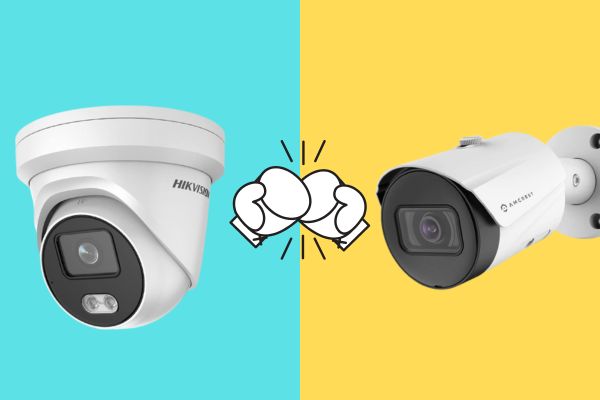Turret and bullet are two distinct types of security cameras with different usage and needs. Turret cameras are typically dome-shaped, often called eyeball cameras; on the other hand, bullet cameras are cylindrical in shape and look like a bullet shell. Whereas Turret cameras are best for both indoors and outdoors, bullet cameras are best for outdoor use only. Not limited to that, there are other factors to deciding any of the two camera types. Between bullet and turret cameras, if you need to choose one, we bring you an in-depth comparison to help you figure out which one is best for you.
Table of Contents
Bullet vs turret camera- Overview
Turret Camera Review- At a Glance

Turret security cameras offer reliable surveillance systems for small to medium areas, including your home or business. You can easily mount them on the ceiling or in the wall to monitor your house, backyard, warehouse, or parking lots. These cameras house full HD up to 4K resolution that captures clear footage. Besides, turret cameras are also great for nighttime surveillance since they feature in-built IR sensors and advanced night vision technology (EXIR night vision).
Pros
- Easier to install on ceilings
- Compact and easy to hide
- Capture clear images and footage
- High-quality night vision
- Flexible rotation capacity
- Features Motion detection and remote access
- Cost-effective surveillance system
Cons
- Not effective for larger area coverage
Bullet Camera Review- At a Glance

Bullet cameras are a popular and reliable choice for both residential and commercial surveillance, especially for outdoor settings like parking lots, entryways, and building perimeters. Bullet cameras feature full HD up to 4K resolution, built-in infrared lights, and smart night vision technology. As a result, bullet cams can capture clear images in low-light or complete darkness. Bullet cameras are durably built, weather resistant, and ideal for outdoor surveillance systems.
Pros
- Longer monitoring range
- Better weather-resistant capacity
- Easier to install on the wall
- Easy visibility prevents unethical acts
- Clearer area coverage during the night
- Customizable lenses and field view
Cons
- Most cameras feature fixed viewing angle
- Can not be installed everywhere due to its unique shape
Bullet vs Turret Camera- Comparison
Purpose Of The Camera
The main purpose of any security camera, however turret or bullet, is to capture clear footage to enhance security surveillance. While comparing bullet and turret cameras, turret cameras are best for indoor and outdoor, especially for small to medium areas like a warehouse, parking lots, and backyards, as they offer flexible rotating features by which you can monitor the maximum space of your area. Whereas long and narrow fields of view made bullet cameras best for long-distance surveillance systems.
See Also: Arlo Vs Lorex
Place of Installation
Using corded cameras like turret or bullet can be a hassle while relocating since you have to be more careful while placing it. To make your life easier, we have added some expert-recommended locations both for turret and bullet cameras.
See Also: Mounting Cameras To Soffit
Turret cameras
- Indoor locations: Turret cameras are easy to install on the ceiling, pointing downward. By doing so, you can monitor large indoor spaces such as warehouses, retail stores, and lobbies.
- Outdoor locations: You can also install turret cams on walls or poles, pointing in any direction. Then, you can easily inspect outdoor areas such as parking lots, building entrances, and public spaces.
Bullet cameras
- Outdoor locations: Exterior walls are the best place to install outdoor bullet cams. These cameras have fixed views, so you have to point a bullet camera in your desired direction.
Design
The most noticeable difference between bullet and turret cameras is in their physical design. Here, we have listed out some key design differences between turret and bullet cameras:

Turret cameras
- Dome-shaped design: Turret cameras have a dome-shaped design that you can keep in a hidden space, making the camera less obtrusive and more aesthetically pleasing than bulky bullet cameras.
- Flexible rotation: Turret cameras have a rotating dome that allows you to pan, tilt, and zoom the camera to see a wider field view.
- Infrared LEDs: Turret cameras often have in-built infrared LEDs, which provide clearer night vision in the dark.
Bullet cameras
- Cylindrical design: The cylindrical design of bullet cameras is more noticeable. These cameras have sturdy built and good weather-resistant capacity, so you can install them in any rugged location.
- Long-range view: Bullet cameras have a narrow field of view, and they cover less width than turret cameras, making them ideal for long-range surveillance in a fixed direction.
- Varifocal lens: Bullet cameras often feature varifocal lens, which allows the user to adjust the focus of the camera for different distances.
Range
The range and field of view between the bullet and turret camera are slightly different. The turret cameras can cover wider surroundings and feature up to 180-degree viewing angles with rotation capacity. On the other hand, most bullet cameras have fixed views for covering longer distances (more than 100 ft) than width.
Video Quality
Both turret and bullet cameras offer high-quality resolution up to 4k that captures clear and detailed images and video footage. Turret cameras feature a wide dynamic range of functions which is capable of capturing footage in different lighting conditions in the dark. On the other hand, bullet cameras have in-built IR LED lights to cover longer distances at night.
Cost
While comparing the price tag between bullet and turret camera, both type of cameras offers cheap models as well as high-tech security cameras. Basic models of turret and bullet cameras start from $30 to $50, mid-range cameras range from $100 to $300, and high-end cameras with advanced feature range between $300-$500.
Final Thoughts
Both Turret and Bullet security cameras have their advantages and disadvantages. Turret security cameras have rotation capacity, but these cameras cannot cover as long distances as bullet cameras. On the other hand, bullet cameras don’t have rotation capacity, but they can cover longer areas than turret cams. However, remember that bullet cams are bulky and easily visible to burglars, so these cameras can be more prone to vandalism.

